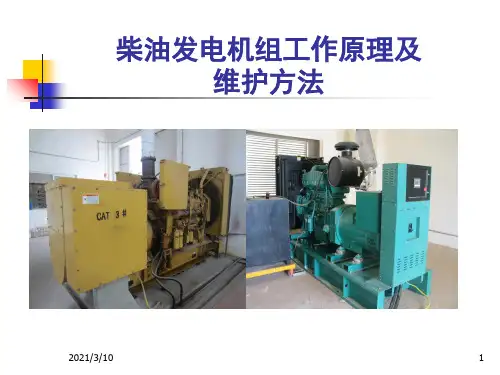KOHLER发电机组日常维护课件
- 格式:ppt
- 大小:410.50 KB
- 文档页数:50

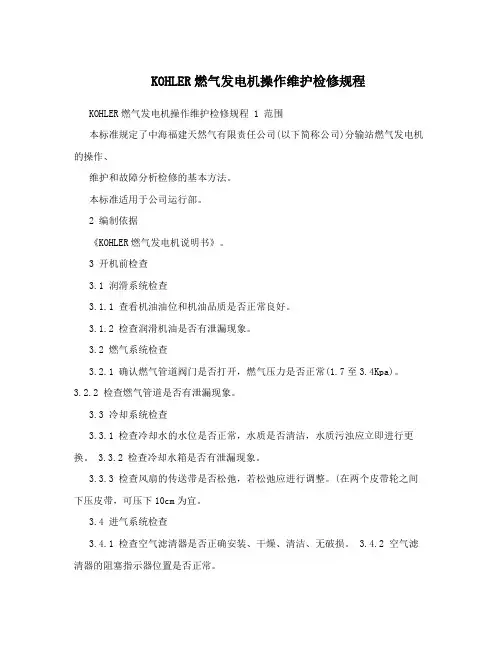
KOHLER燃气发电机操作维护检修规程KOHLER燃气发电机操作维护检修规程 1 范围本标准规定了中海福建天然气有限责任公司(以下简称公司)分输站燃气发电机的操作、维护和故障分析检修的基本方法。
本标准适用于公司运行部。
2 编制依据《KOHLER燃气发电机说明书》。
3 开机前检查3.1 润滑系统检查3.1.1 查看机油油位和机油品质是否正常良好。
3.1.2 检查润滑机油是否有泄漏现象。
3.2 燃气系统检查3.2.1 确认燃气管道阀门是否打开,燃气压力是否正常(1.7至3.4Kpa)。
3.2.2 检查燃气管道是否有泄漏现象。
3.3 冷却系统检查3.3.1 检查冷却水的水位是否正常,水质是否清洁,水质污浊应立即进行更换。
3.3.2 检查冷却水箱是否有泄漏现象。
3.3.3 检查风扇的传送带是否松弛,若松弛应进行调整。
(在两个皮带轮之间下压皮带,可压下10cm为宜。
3.4 进气系统检查3.4.1 检查空气滤清器是否正确安装、干燥、清洁、无破损。
3.4.2 空气滤清器的阻塞指示器位置是否正常。
3.5 排气系统检查3.5.1 检查排气口有无阻塞。
3.5.2 消音器、管道安装是否牢固,并处于良好状态。
3.5.3 防雨盖状态是否良好,管道内有无积水。
3.6 启动电瓶检查3.6.1 检查电瓶电压,若是一个电瓶电压应为12V左右,两个电瓶电压应为24V左右。
3.6.2 检查电瓶接线,接头应牢固、无氧化物、接线应正确无误。
3.6.3 检查电瓶液是否足够。
3.6.4 电瓶的浮动电压应在13V或26V以上。
3.7 检查测试灯拨动灯光测试开关,所有指示灯应均能正常显示。
4 启动4.1 现场机侧启动4.1.1 将发电机控制器上的开关置于“RUN”位置(图1),发电机将自动运行。
4.1.2 注意,开关未置于“AUTO”位时(图1),“ NOT IN AUTO”灯会亮且报警(图2)。
4.2 自动启动4.2.1 当机组采用自动启动时,将机组主开关置于“AUTO”位。
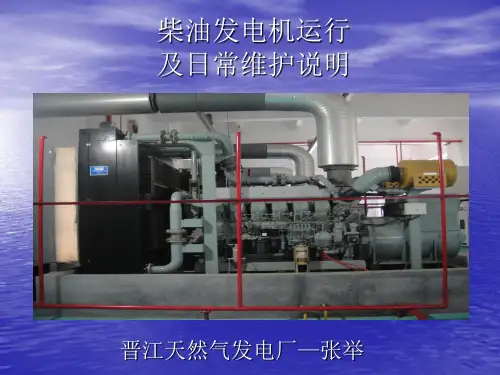
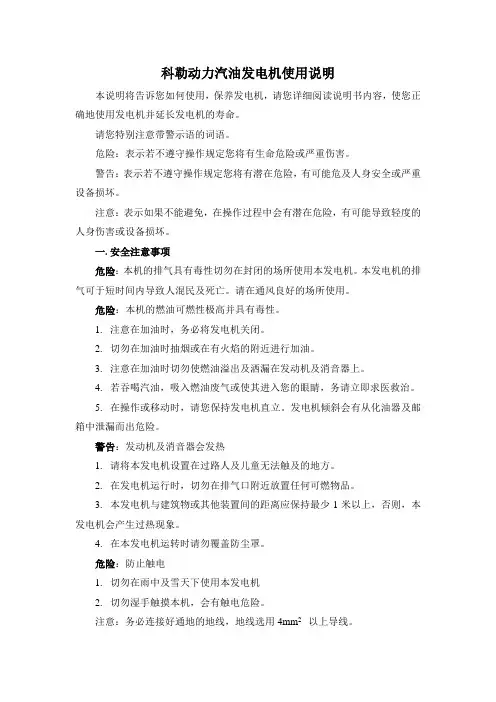
科勒动力汽油发电机使用说明本说明将告诉您如何使用,保养发电机,请您详细阅读说明书内容,使您正确地使用发电机并延长发电机的寿命。
请您特别注意带警示语的词语。
危险:表示若不遵守操作规定您将有生命危险或严重伤害。
警告:表示若不遵守操作规定您将有潜在危险,有可能危及人身安全或严重设备损坏。
注意:表示如果不能避免,在操作过程中会有潜在危险,有可能导致轻度的人身伤害或设备损坏。
一.安全注意事项危险:本机的排气具有毒性切勿在封闭的场所使用本发电机。
本发电机的排气可于短时间内导致人混民及死亡。
请在通风良好的场所使用。
危险:本机的燃油可燃性极高并具有毒性。
1.注意在加油时,务必将发电机关闭。
2.切勿在加油时抽烟或在有火焰的附近进行加油。
3.注意在加油时切勿使燃油溢出及洒漏在发动机及消音器上。
4.若吞喝汽油,吸入燃油废气或使其进入您的眼睛,务请立即求医救治。
5.在操作或移动时,请您保持发电机直立。
发电机倾斜会有从化油器及邮箱中泄漏而出危险。
警告:发动机及消音器会发热1.请将本发电机设置在过路人及儿童无法触及的地方。
2.在发电机运行时,切勿在排气口附近放置任何可燃物品。
3.本发电机与建筑物或其他装置间的距离应保持最少1米以上,否则,本发电机会产生过热现象。
4.在本发电机运转时请勿覆盖防尘罩。
危险:防止触电1.切勿在雨中及雪天下使用本发电机2.切勿湿手触摸本机,会有触电危险。
注意:务必连接好通地的地线,地线选用4mm2 以上导线。
危险:接线注意事项1.禁止将本发电机连接在商用电源插孔上。
2.禁止将本发电机与其他发电机进行连接。
3.市电,发电,负载之间切换,应采用互锁开关来连接。
二.使用前的准备和检查1.燃油:(油箱容积为21L)必须使用(无铅)汽油90#以上。
取下燃油箱盖(逆时针旋转),加注燃油,并随时观察油箱上的油位计。
加油时不要把加油口的燃油过滤网取出。
(加油时,应停止发动机,十分小心周围的烟火)注意:发动机运转或尚未冷却之间,禁止往燃油箱里加注燃油,加注燃油之前,必须关闭燃油油路开关。
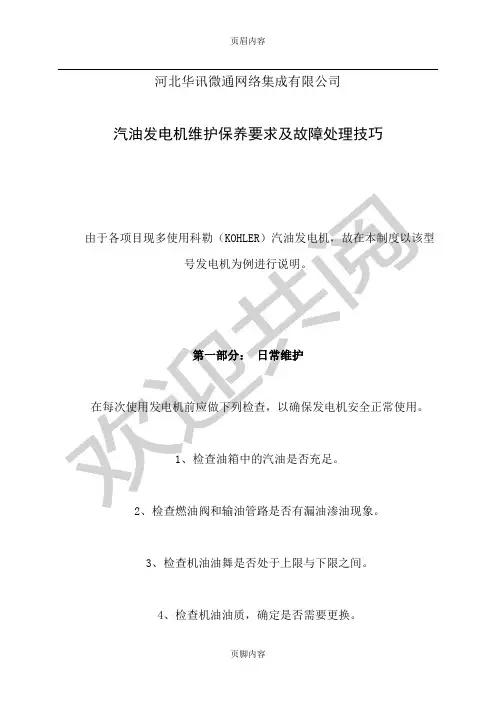
河北华讯微通网络集成有限公司汽油发电机维护保养要求及故障处理技巧3、检查机油油舞是否处于上限与下限之间。
4、检查机油油质,确定是否需要更换。
5、检查启动电池电压是否在12V以上,并观察电池外观是否有破损漏液现象。
6、如发电机长时间不用(一个月以上),启动电池会因自放电而亏电,应用外接充电器给电池充电。
采用粘度为SAE10W30,API等级为SG、SH、SJ或更高的清洁机油)2、空气滤芯的更换和保养发电机每使用100小时需清理空气滤芯,每200小时必须更换。
恶劣环境下需增加清洁次数,必要时更换。
1)、将空气滤芯盖取下,轻轻地卸下外侧海棉,用温水浸泡洗净,不得拧洗。
3)、检查火花塞间隙,正常为0.7~0.8毫米。
4、油箱和滤网的清洁、汽油滤芯的更换发电机每使用300小时或一年后,应清洁油箱、燃油阀及其滤网,并更换汽油滤芯。
A、燃油阀的清洗1)、将燃油阀门杆转至OFF位置。
3)、擦干过滤器,将其插入燃油箱。
C、燃油滤芯的清洗发电机每使用300小时或一年后,应更换汽油滤芯(若所使用汽油杂质过多,则应酌情提前更换)。
更换时同时检查油管是否有断裂现象,酌情更换。
5、启动电池的维护二、汽油机点火系统常见故障排除方法三、汽油机综合故障检修汽油机往往油路、电路和其它部位同时出现故障,产生较为复杂的故障现象,有时不同的故障点会出现相似的现象,给分析排除故障造成一定的困难。
但只要根据现象,采取不同的判断方法和观察手段,如看、听、嗅、摸、搭起子、接地法、看火花和关风门等,把观察所得的各种故障现象联贯起来分析思考,找出故障的特有现象,设想出各种可能产生故障的原因并加以分析比较,就可确定故障的范围和部位。
然后由简到繁,由外到内,先电路后油路,再校点火时间,查配气定时的次序,把故障压缩到到启动转速等,然后本着先检油路,后检电路,再检气缸压缩的顺序排除故障。
首先,打开曲轴箱放油开关,迅速拉动机器,通过观察流油情况区别故障范围。
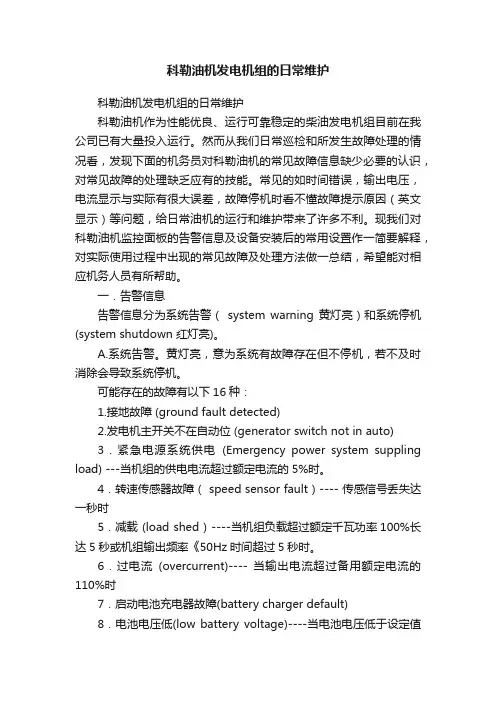
科勒油机发电机组的日常维护科勒油机发电机组的日常维护科勒油机作为性能优良、运行可靠稳定的柴油发电机组目前在我公司已有大量投入运行。
然而从我们日常巡检和所发生故障处理的情况看,发现下面的机务员对科勒油机的常见故障信息缺少必要的认识,对常见故障的处理缺乏应有的技能。
常见的如时间错误,输出电压,电流显示与实际有很大误差,故障停机时看不懂故障提示原因(英文显示)等问题,给日常油机的运行和维护带来了许多不利。
现我们对科勒油机监控面板的告警信息及设备安装后的常用设置作一简要解释,对实际使用过程中出现的常见故障及处理方法做一总结,希望能对相应机务人员有所帮助。
一.告警信息告警信息分为系统告警(system warning 黄灯亮)和系统停机(system shutdown 红灯亮)。
A.系统告警。
黄灯亮,意为系统有故障存在但不停机,若不及时消除会导致系统停机。
可能存在的故障有以下16种:1.接地故障 (ground fault detected)2.发电机主开关不在自动位 (generator switch not in auto)3.紧急电源系统供电(Emergency power system suppling load) ---当机组的供电电流超过额定电流的5%时。
4.转速传感器故障( speed sensor fault)---- 传感信号丢失达一秒时5.减载 (load shed ) ----当机组负载超过额定千瓦功率100%长达5秒或机组输出频率《50Hz时间超过5秒时。
6.过电流(overcurrent)---- 当输出电流超过备用额定电流的110%时7.启动电池充电器故障(battery charger default)8.电池电压低(low battery voltage)----当电池电压低于设定值超过10秒时。
9.电池电压高(high batteryvoltage)----当电池电压高于设定值超过10秒时。
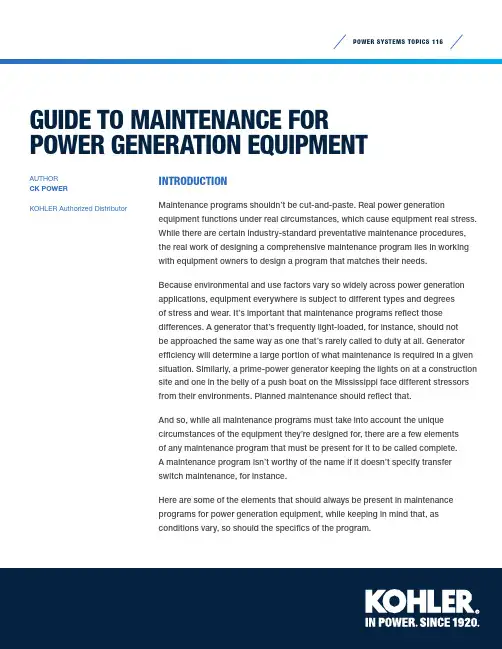
POWER SYSTEMS TOPICS 116GUIDE TO MAINTENANCE FOR POWER GENERATION EQUIPMENTAUTHORCK POWERKOHLER Authorized Distributor INTRODUCTIONMaintenance programs shouldn’t be cut-and-paste. Real power generation equipment functions under real circumstances, which cause equipment real stress. While there are certain industry-standard preventative maintenance procedures, the real work of designing a comprehensive maintenance program lies in working with equipment owners to design a program that matches their needs.Because environmental and use factors vary so widely across power generation applications, equipment everywhere is subject to different types and degreesof stress and wear. It’s important that maintenance programs reflect those differences. A generator that’s frequently light-loaded, for instance, should notbe approached the same way as one that’s rarely called to duty at all. Generator efficiency will determine a large portion of what maintenance is required in a given situation. Similarly, a prime-power generator keeping the lights on at a construction site and one in the belly of a push boat on the Mississippi face different stressors from their environments. Planned maintenance should reflect that.And so, while all maintenance programs must take into account the unique circumstances of the equipment they’re designed for, there are a few elementsof any maintenance program that must be present for it to be called complete.A maintenance program isn’t worthy of the name if it doesn’t specify transfer switch maintenance, for instance.Here are some of the elements that should always be present in maintenance programs for power generation equipment, while keeping in mind that, as conditions vary, so should the specifics of the program.2 / Guide to MaintenanceE ng in eCo o l i n g & F il tr ati o nR ad i at o r A i rf lo wF ue lCo nd o n S t o r a i ng sressure and coolant temp Fuel lines/filters/fittingsDC electrical systems batteries Structures (cleaning/inspection)Racking mechanisms • Change engine oil and filter(s)• Record lube oil pressure • Clean crankcase breather • Record coolant level and mixture • Record coolant temperature • Check belt tension and condition • Change water filter(s)• Check ductwork for defects • Check block heater operation • Check coolant hoses and connections • Check for oil/coolant leakage • Belt and hose replacement • Thermostat replacement• Air filter replacement• Air cleaners–check/oil for element • Check for fuel leaks • Change fuel filter• Check exhaust system for leaks• Check battery specific gravity, electrolytelevel and clean connections • Check battery charger operation • Inspect ignition wiring, if equipped • Check ignition timing, points and plugs, if equipped • Battery replacement• Coolant removal and replacement • Radiator hose and fitting replacementPLANNED SERVICE AGREEMENTSWhether for a generator or another piece of power generation equipment, the purpose of a planned service agreement is to enhance the performance and reliability. By providing regular maintenance, these programs minimize the likelihood of an equipment malfunction. Planned service agreements must be executed as a combination of inspection and services by trained technicians to be effective. Following these inspections, the technician should be able to deliver a detailed status report to the asset owner.Following is a list of services typically rendered as part of a planned service agreement:The above is a partial list of some of the services and inspections equipment owners may expect to be covered as part of a planned service agreement. Other services like antifreeze sampling, oil sampling, fuel sampling and load bank testing for generators are recommended on an annual basis. Things like battery and belt and hose replacements are generally scheduled at longer, but still regular, intervals.TRANSFER SWITCH PREVENTATIVE MAINTENANCEIn the case of emergency generators, transfer switch preventative maintenance is an essential element in verifying equipment health. Transfer switches are responsible for ensuring a continuous source of power to a facilityby automatically transferring from a prime power source to an emergency one in the event the primary power source falls belowa predetermined voltage. In other words, ifa transfer switch is faulty, your emergency generator will fail to kick on when your primary power source fails. Hence, it’s absolutely critical that preventative maintenance plans are in place for this crucial piece of equipment. In fact, the National Fire Protection Association (NFPA) code 110 mandates that transfer switches be maintained at least annually.Here are the procedures a trained technician would generally follow for the cleaning and systems check for a transfer switch:• De-energize the engine start signals• Check interior of transfer switch cabinet• Clean control board areas and relay cases, checkfor loose or missing relays• Check control wiring connections and wirebundle runs for abrasions• Lubricate necessary moving parts withmanufacturer’s recommended lubricationwhere applicable• Test all lights and note which are in needof replacement• Inspect mechanical and electrical interlockswhere applicable• Inspect timing functions and record if possible • Inspect arc shields for proper installationand condition• With the customer’s consent, inspect emergencyand main contactors (contactors on nonbypassswitches will necessitate operation of transferswitch in the bypass side of switch only)• Inspect control contacts• Bypass switches will be placed in bypass toinspect main contacts by means of placing bypass to the preferred source (utility) and placing the auto part of the switch disconnect and removing fromthe ATS cabinet• Indicate deficiencies and recommend repairs• Re-energize the engine start signals• Initiate bypass switches in test modeNonbypass switches will not be actuatedunless authorized• Thermal imaging of ATS onlyFINDING YOUR MAINTENANCE PARTNERA maintenance contractor who’s not interested in the specific circumstances of your power generation equipment should set off some immediate red flags. It’s imperative that a planned maintenance program is tailored to your needs, yet follows the manufacturer’s published service requirements. Trained, certified and experienced technicians should be the next element customers insist upon. Without expertise, it’s far too easy for potential issuesto go unnoticed, for repairs to be botched or for the wrong procedures to be conducted.Guide to Maintenance / 3CK Power is a proud distributor and authorized service provider of KOHLER ® power since 1976. It has been a leading manufacturer of power units and power generation solutions for a variety of markets and customers. Its mission is to continually expand and improve its power solutions product offering no matter the application, fuel type or power rating. It also provides generator maintenance and planning to ensure your equipment is ready no matter what. For more information, visit CK Power at Printed in U.S.A. G26-28 KPS 116 7/18 © 2018 by Kohler Co.A global force in power solutions since 1920, Kohler is committed to reliable, intelligent products; purposeful engineering and responsive after-sale support. Kohler and SDMO are among the world’s largest manufacturers of industrial generators. The companies have a combined 150 years experience in industrial power and benefit from global R&D, manufacturing, sales, service and distribution integration.ABOUT THE AUTHORSABOUT KOHLER。
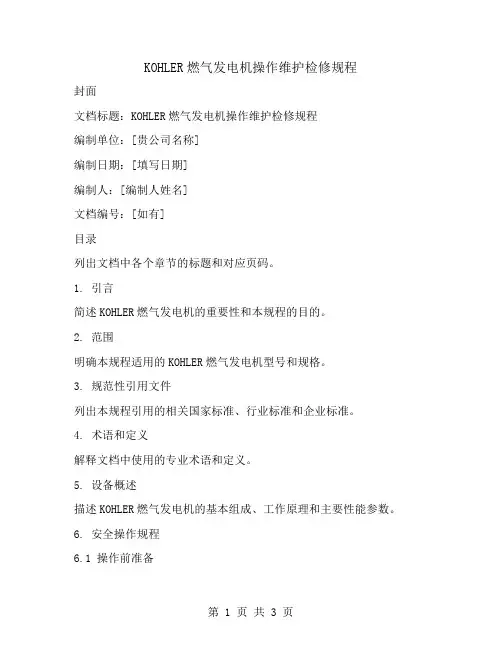
KOHLER燃气发电机操作维护检修规程封面文档标题:KOHLER燃气发电机操作维护检修规程编制单位:[贵公司名称]编制日期:[填写日期]编制人:[编制人姓名]文档编号:[如有]目录列出文档中各个章节的标题和对应页码。
1. 引言简述KOHLER燃气发电机的重要性和本规程的目的。
2. 范围明确本规程适用的KOHLER燃气发电机型号和规格。
3. 规范性引用文件列出本规程引用的相关国家标准、行业标准和企业标准。
4. 术语和定义解释文档中使用的专业术语和定义。
5. 设备概述描述KOHLER燃气发电机的基本组成、工作原理和主要性能参数。
6. 安全操作规程6.1 操作前准备说明启动前的安全检查和准备工作。
6.2 启动程序详细描述发电机启动的步骤和注意事项。
6.3 运行监控阐述运行过程中的监控要点和数据记录。
6.4 停机程序描述发电机停机的正确步骤和后续工作。
7. 日常维护7.1 维护周期规定日常维护的周期和检查项目。
7.2 维护内容详细说明日常维护的具体内容和方法。
8. 定期检修8.1 检修周期规定定期检修的时间间隔和检修项目。
8.2 检修内容详细描述定期检修的步骤、检查要点和维护措施。
9. 故障诊断与排除9.1 常见故障列举KOHLER燃气发电机可能遇到的常见故障。
9.2 故障诊断描述故障诊断的方法和步骤。
9.3 故障排除提供故障排除的指导和建议。
10. 紧急情况处理描述紧急情况下的操作程序和应急措施。
11. 维护记录规定维护记录的内容、格式和保存方法。
12. 附录附录A:KOHLER燃气发电机技术参数表附录B:维护和检修记录表附录C:故障诊断流程图附录D:安全操作和紧急情况处理流程图结束语强调规程的重要性,并对遵循规程的员工表示感谢。


